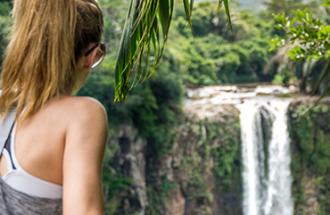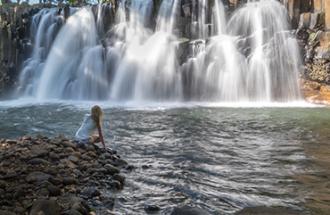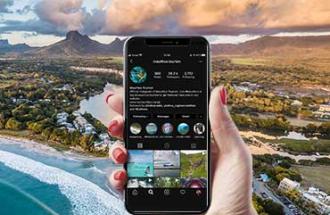Where to Stay
When planning your stay in Mauritius, you need to choose which region will suit you best. Although it is a small island, Mauritius benefits from a microclimate and different landscapes and lifestyles depending on the region. Warmer and more touristy in some places while other areas are more preserved and windier. The centre will immerse you in the buzz of Mauritian urban lifestyle. A wide choice of accommodation is available in all regions, from big luxury hotels to boutique-hotels, guest houses and other charming residences.
The North
The North of Mauritius is the most popular tourist area of the country. Tourism took off in this region more than 40 years ago. This part of the island includes the most beautiful sandy beaches protected from the wind all year round, perfect for sunbathing and swimming, like Grand-Bay, Péreybère, Trou aux Biches or Mont Choisy. These seaside villages comprise of a concentration of hotels, various restaurants and all sorts of shops.
For those who are looking for more tranquillity, Cap Malheureux will offer you this feeling of authenticity, with its famous red-roofed chapel, Notre-Dame Auxiliatrice, the whereabouts of the fishermen with their catch of the day and the indolence of life by the sea, facing the northern islands. The villages of Bain Boeuf and Anse la Raie will also appeal to you.
The East
A completely different landscape will be unveiled to you in the eastern part of the country. Beautiful beaches that seem to spread to infinity, small authentic villages and a choice of luxury hotels are available to you there. The East is the windiest part of Mauritius, pleasant in summer and cooler in winter. The beach at Belle Mare is a dream with its stretch of fine sand as far as the eye can see. It is also the region where the Île aux Cerfs is located, a small idyllic island for holidaymakers, with its beautiful beaches, its wide selection of nautical activities and its golf course. The islet is accessible by boat from Trou d'Eau Douce or Pointe Maurice. It can also be part of a catamaran day out in the south-east region.
Further north, Roches-Noires, Bras d'Eau and Poste Lafayette exude tranquillity. Their beaches may not be the most attractive ones, sometimes dangerous in some places, but they form a scenery that will appeal to nature lovers. Bras d'Eau National Park is a call for walks in the forest among endemic trees and protected animals and to reconnect with nature.
Heading south, you will discover a less known aspect of Mauritius, far from postcards. The villages of Trou d'Eau Douce, Beau Champ, Grande-Rivière Sud-Est and Vieux Grand Port will give you unexpected settings between the Grand Port mountain range and the ocean. Do not hesitate to visit the small villages of this region with certain charm.
The South
Called the Wild South, this part of the island deserves its name. An ocean in continuous motion, impressive cliffs, and sugar cane fields as far as the eye can see and villages that take you back in time, this is the beauty of the region. This part of the island is an invitation to those who want to get closer to nature and local life. It does not have the most beautiful sandy beaches, but is definitely exceptional. Gris-Gris with its steep cliffs and constantly raging waves, Pont Naturel (Natural Bridge), Souillac with its historic remains and the Rochester Falls, Baie du Cap, Bel Ombre and Le Morne with its impressive mountain, are worth staying around.
The road from Macondé to Baie du Cap is a must during your stay in Mauritius. The Macondé promontory overlooking the ocean is one of the most photographed sites of the island. Climb to the top and you will be stunned by the view! La Vanille Park at Rivière des Anguilles is also to be included in your itinerary. You will meet giant turtles and crocodiles and discover a unique insectarium.
On the sea side, the most popular beaches are Blue Bay in Mahebourg, which is also a protected marine park, St Félix and Le Morne, ideal for the family but also very popular among surf and kitesurf enthusiasts. The region of Mahebourg is rich in history, having long been the main port of the island and witnessed many battles. The waterfront and the small streets of the village will offer you great opportunities to meet the locals.
The West
The west coast is another facet of Mauritius to discover. Protected from the winds and enjoying a mild temperature and low rainfall all year round, it is very similar to the African savanna landscape. Flic-en-Flac, Tamarin and Le Morne are the most popular seaside villages.
Flic-en-Flac is very popular among tourists, especially those who come with their family, with its beautiful beach, its numerous restaurants and street-food trucks, and the proximity to the centre of the island. The village features several large hotels as well as many holiday residences. A few minutes away, the Casela Park proposes to discover a multitude of animals and many activities to practise surrounded by nature. The Black River Gorges National Park is located a few kilometres further south and is home to an extraordinary protected fauna and flora, perfect for rejuvenating in the heart of nature. The marked trails of the park will lead you to the centre of the island, in the region of Plaine Champagne.
Kitesurfing and surfing enthusiasts will obviously opt for the villages of Tamarin and Le Morne, which are very popular with surfers. This region is also home to dolphin populations that can be observed during a catamaran outing or a motor boat trip. Black River is also the privileged place for Big Game fishing. International competitions are held at the beginning of each year.
If you move away from the coast, climb up to Chamarel via Case Noyale, and enjoy the fresh air and authentic atmosphere of this village. Discover the Seven Coloured Earth, the Ebony Forest, the Chamarel Rum Factory, among other places of interest. This road will also take you to the centre, to Grand Bassin, the Ganga Talao, the sacred lake where pilgrims of Hindu faith converge each year. This ancient flooded crater is surrounded by multiple statues of deities and places of worship. You will also be able to meet monkeys who stroll freely there.
The Centre
The centre of the island stands out completely from the coastal region with a cooler climate, being located higher (400-600 meters above sea level) and denser in terms of population. Unexpectedly, it houses a large part of the Mauritian forest and green areas outside the cities. All the towns of the country are located there: Beau-Bassin/Rose-Hill, Quatre-Bornes, Vacoas/Phoenix, and Curepipe. Port-Louis, the capital city, is on the northwest coast.
The towns have a large concentration of shops, clothing fairs and restaurants. Although there is constant activity during the day, cities no longer have activities after 18 hours, except for restaurants. If you are in Rose-Hill for your shopping, you can take a break in the Balfour Garden, a few minutes from the centre for a breath of fresh air and enjoy the view of the gorges.
Shopping in Quatre-Bornes is recommended, especially on Thursdays and Sundays, days for the clothing fair – many good deals to grab! Vacoas is not known for shopping, but more for the Gymkhana golf course, the oldest in the southern hemisphere. The coolest town, Curepipe, is perfect for shopping, with an interesting choice of outlets and souvenir shops. Make a stopover at the botanical garden for a tour in a beautiful park among rare trees, and drive to the top of Trou aux Cerfs, a sleeping volcano crater, to see the centre of the island from above.




